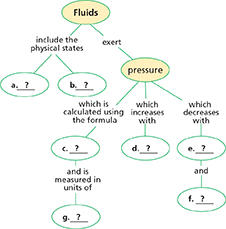CHAPTER 13 Study Guide
13.1 Fluid Pressure
 Key Concepts
Key Concepts
Pressure
Water pressure increases as depth increases.
The pressure in a fluid at any given depth is constant and is exerted equally in all directions.
Air pressure decreases as altitude increases.

Vocabulary
pressure, p. 390
pascal, p. 391
fluid, p. 391

13.2 Forces and Pressure in Fluids
 Key Concepts
Key Concepts
According to Pascal's principle, a change in pressure at any point in a fluid is transmitted equally and unchanged in all directions throughout the fluid.
In a hydraulic lift system, an increased output force is produced by a constant fluid pressure exerted on the larger area of the output piston.
According to Bernoulli's principle, as the speed of a fluid increases, the pressure within the fluid decreases.
Vocabulary
hydraulic system, p. 395
lift, p. 396

13.3 Buoyancy
 Key Concepts
Key Concepts
Buoyancy results in the apparent loss of weight of an object in a fluid.
If an object is less dense than the fluid it is in, it will float. If the object is more dense than the fluid it is in, it will sink.
When the buoyant force is equal to the weight, an object floats or is suspended. When the buoyant force is less than the weight, the object sinks.
Vocabulary
buoyancy, p. 400
buoyant force, p. 400
Archimedes' principle, p. 401
Thinking Visually
Use the information from the chapter to complete the concept map below.





